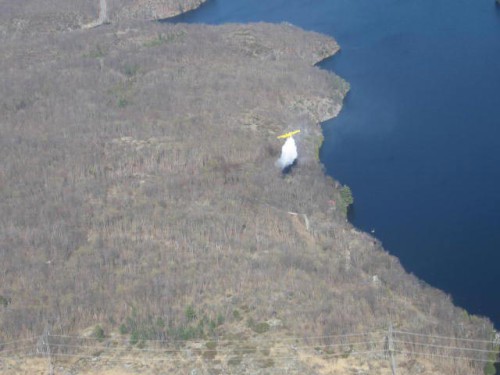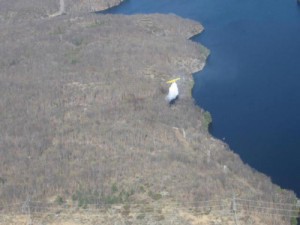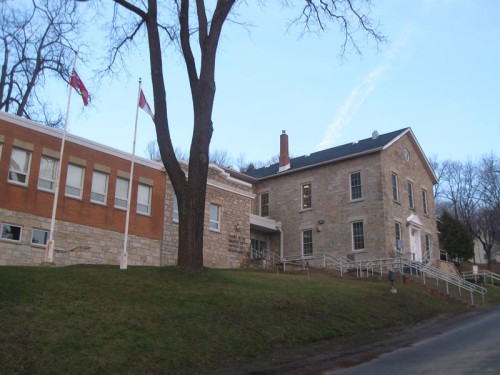MANITOULIN—Manitoulin residents are being asked to exercise caution when using anything flammable, whether it’s matches, cigarettes or barbecues, now that an extreme fire hazard has been declared for the region and a fire north of Gogama has consumed more than 25,000 hectares of forest.
Much of Northeastern Ontario is under an extreme fire hazard warning as of May 21, and has been under a fire restriction since May 16. At least one Island community, Northeast Town, has issued its own fire restriction prior to the ministry-issued ban. The MNR fire ban automatically results in the suspension of all fire permits.
“The fire hazard is high to extreme,” a press release from the MNR stated. “The outlook for the next several days calls for continued drying.”
Several fires raging in the North near Timmins and Gogama have forced the evacuations of several communities, campgrounds and have resulted in closed highways, the MNR revealed on May 21. The largest fire in the province, Timmins 9, had consumed 25,800 hectares as of press deadline on Monday.
Though there have not been fires requiring the assistance of the MNR on the Island this season, the conditions are perfect for a blaze.
“Starting or tending a campfire in a restricted fire zone can lead up to a fine of up to $1,000,” Lindsay Marks, an MNR spokesperson, explained. “The restriction does not, per se, restrict the use of fireworks. However, a town may have a fire ban in place so you have to check.”
Ms. Marks also warned that if someone has a fire or sets off fireworks, “in a restricted fire zone and a fire starts from those fireworks, you can be held responsible for the cost of suppression and damages.”
Depending on the size of the blaze, the cost can run into the thousands of dollars.
During a fire restriction there aren’t restrictions on activities like camping, hiking or fishing, but the MNR warns people partaking in those activities to exercise caution.
“Have fun and enjoy our most precious natural resource, but if you need heat for cooking and warmth, you’ll have to take along a portable gas or propane stove,” the MNR website reads. “Smoke only when stationary and never while walking or working in the bush. Make sure that all matches or cigarettes are dead out before disposing of them.”
The MNR also asks motorists to not dispose of their cigarettes through the window, as many roadside blazes have been traced in the past to dry brush catching on fire from lit cigarette butts.
“Use your bush sense and act accordingly,” the MNR states, adding, “Be careful with anything capable of starting a fire.”
The fire restriction comes at a popular time in the cottage season, as cottagers are travelling to open their summer getaways after a cold and dreary winter season. Residents should be aware that the fire restriction limits the use of barbecues and outside stoves as well.
“You can use a portable gas or propane stove (i.e. barbecue) anywhere and at any time, provided it is at least one metre from any flammable materials and you use extreme caution,” instructs the MNR website.
However, charcoal installations, such as grills or barbecues, are limited by the fire restriction. While they can be used, they can be operated “only if you are within 100 metres of a dwelling you own or legally occupy,” the MNR explained. “You must completely extinguish and safely dispose of all ashes and coals before the installation is moved or left unattended.”
Wood-burning stoves or furnaces can be used if allowed under municipal bylaws and provided the use is within 100 metres of a dwelling owned or legally occupied by the person tending the fire. The stove or furnace must also be at least five metres from any forest area, two metres from any flammable material, and must be situated on bare rock, mineral soil or other non-flammable materials, and that material must extend at least two metres in all directions. This means the stove or furnace cannot be on a wooden deck.
“You cannot have a campfire even in an outdoor fire grate, fire place or fire pit,” Ms. Marks informed The Expositor. “Campfires may be allowed at some organized campgrounds or parks that use approved fire pits and meet certain other criteria.” She advised interested persons to speak with the owners or operators before starting a fire, as the owners of campgrounds must obtain permission from the MNR, and the choice on whether fires are allowed or not remains in the hands of federal and provincial park operators.
People disobeying the ban can be stuck with a fine of up to $1,000 from the MNR and may face additional fines from the municipality if they are in contravention of existing fire bylaws or restrictions.
The ministry is also cautioning boaters to keep an eye open for the CL-415 Waterbombers, airplanes that scoop up water from lakes to drop on nearby fires.
“Curiosity drives people and nothing draws a crowd faster than a CL-415 Heavy Waterbomber scooping water and dropping it on a forest fire,” a press release from the MNR noted. “The big tankers are a combination of power, size and acrobatic movement as they swoop down from the sky, skimming across the lake at high speed, scooping water through small probes on the under body and then lifting off and flying to a wildfire target.”
However, that curiosity can cause problems, the MNR revealed.
“The operation of waterbombers is strictly regulated and if boaters come too close or there is any potential safety hazard, the waterbombers will be forced to find another location to scoop water,” the press release continued. “This may place them further away from the fire and result in a longer turnaround time to get water on the fire. When every minute counts in wildfire management, an unnecessary delay in waterbombing could be critical.”
To prevent waterbombers from having to seek out a new water source, the MNR has several tips. Boaters should move away from the area immediately to prevent collision as well as avoid a potential capsize, as the water collection can cause a large wake.
“It is important to know that waterbombers usually operate in circuits flying to the lake, scooping, and flying to drop off their load on the fire, then circing back to repeat the process,” the MNR noted. “This means boaters have to watch for the plane’s return. So, for the safety of everyone, boaters are encouraged to move away from any area where waterbombers are scooping.”
As of May 21, there have been 252 forest fires in Ontario so far this season, well above the 10-year average of 161. Of those fires, 141 have been in the Northeast region. There are 38 forest fires currently burning in the province, with only two of those not in the Northeast region. The fires have caused 6,842 hectares of burnt forest, and more than 27,000 hectares burning at present. To put that into perspective, a hectare is roughly the size of a football field. Prior to the Timmins 9 fire, the largest fire burning in the province was slightly more than 3,000 hectares in size.





